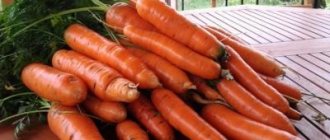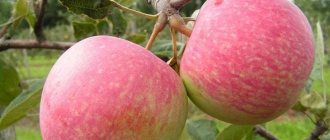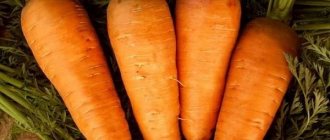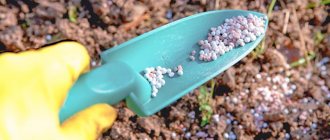Characteristics and description of the variety
A detailed description will help you get an idea of the variety.
What does it look like?
- Carrots have a conical shape and grow up to 11-17 cm. The upper part of the root crop is flat, the end is pointed.
- The color is bright orange.
- The core is small in size and does not differ in color from the main pulp.
- Carrots are juicy, sweet, and do not leave a bitter aftertaste.
- The leaves are long and dark green in color.
- Spreading rosette.
What variety does it belong to?
Red Core is a representative of the Shantanay variety . It shares genetic traits with this carrot.
Amount of fructose and beta carotene
100 g of root vegetables contain 10 g of fructose. And also 27 mg of beta-carotene.
Sowing time
When growing this variety, you can adhere to early, medium or late sowing dates. Carrots are planted from early April to mid-June. In spring, sowing begins when the air temperature reaches 15˚C and the soil warms up to 8˚C.
Red Cor is planted before winter at the end of November, when the average daily temperature is +2˚С.
Seed germination
The germination rate of planting material reaches 45-70%. This number of sprouts is formed from all seeds.
Average weight of 1 root vegetable
The average weight of the root crop is 100-140 g.
What is the yield per 1 hectare?
Yields are high . 40-45 tons of root crops are obtained from 1 hectare.
Purpose and keeping quality
Red Core is suitable for culinary processing and fresh consumption. It is used in the medical industry for the preparation of medicines and in the agricultural sector as animal feed. Keeping quality reaches 6-8 months.
Regions for vegetable cultivation
These carrots are grown in all regions . Red Core grows well in the northern, southern and central regions.
Where is it recommended to grow?
The variety is suitable for open ground and growing in greenhouses.
Resistance to diseases and pests
These carrots exhibit resistance to wet rot and stemming. Resistance to pests is not noted.
Ripening period
Red Cor belongs to the mid-season varieties . The ripening period takes from 90 to 120 days.
On our portal you will find articles with the characteristics and features of growing various mid-season varieties, including Sentyabrina, Champion, Dordogne, NIIOH 336, Losinoostrovskaya 13, Canada F1, Vitaminnaya 6, Samson, Alenka and Boltex.
What soils does it prefer?
Carrots require loamy, sandy, black soil or sandy loam soil. Vegetables should not be planted in heavy soil.
This leads to the fact that the carrot fruits begin to become deformed and their growth slows down. In order for heavy clay soil to become suitable for planting, it is necessary to add 1 sq. m 30 kg of sand.
Then dig the ground 20 cm deep. Plant carrots in slightly acidic (pH 5.0-5.5) or neutral soil (pH 6-7) .
Frost resistance and transportability
Red Cor tolerates frosts down to -4-5˚C. At lower temperatures, the roots become pale in color.
The variety is resistant to transportation. Vegetables do not crack during long-term transportation.
Manufacturability for farmers and peasants
The manufacturability of the variety is assessed as high . Carrots do not require additional care. Good yield indicators and long-term storage allow Red Cor to be used for feeding farm animals.
Planting and care
Priming
Root crops require a careful approach to soil preparation. Timely application of mineral fertilizing will ensure disease prevention and active germination of carrots. There is no need to fertilize with fresh manure; this should happen 2-3 seasons before planting. If the soil is heavy, it should be mixed with river sand, peat, rotted sawdust treated with urea.
Rough soil causes deformation of root crops, which negatively affects their presentation.
In early spring, the surface for sowing is harrowed, which helps preserve soil moisture. Right before planting, it is necessary to loosen to a depth of 20 cm and level.
Sowing
The distance between the furrows should be 20 cm. The planting depth is 3 cm with an interval of 1 cm.
After the first shoots appear, weeding is carried out. The appearance of the second leaf is followed by thinning, taking into account that the distance will be 4-5 cm between plants, and loosening occurs in parallel. After three weeks, thinning is repeated, if necessary.
In a garden plot, strong plants that have been pulled out can be planted in a new place.
Watering
Since young, fragile seedlings need a lot of moisture, it is better to water the seedlings after planting at least once every 3-4 days. This refers to the summer season, when plants in warm beds are most susceptible to drying out and depletion. As the carrot bushes begin to grow, stand, and become stronger, the frequency of watering is reduced to once every 5-7 days. It is better to use water in large quantities, approximately 15 liters per 1 m2.
The intensity of irrigation is influenced by the climatic conditions of a particular area, the type and quality of soil, location relative to groundwater and other important parameters.
It is better to water the seedlings in the morning. Carrots can withstand prolonged drought. If the season is poor in precipitation, then watering can be up to 8 times during the summer. Before harvesting, 2-3 weeks before, excessive moisture can lead to cracking of root crops, so we stop watering and harvest only in dry weather.
Advantages and disadvantages
The positive properties of the variety are:
- high levels of fructose;
- good yield;
- long-term storage;
- resistance to transportation;
- frost resistance;
- unpretentiousness to growing conditions;
- resistance to cracking;
- universal application;
- the ability to resist certain diseases.
The variety also has disadvantages. To store root crops, you need to create special conditions. If you harvest later than required, the taste of carrots will decrease.
Description of Red Cor carrots
The germination rate of seed is 55-70%.
The leaf rosette is spreading. The leaves are long, dissected. The tops are strong, thick, dark green in color. Carrots are characterized by excellent root taste, juiciness, and pleasant aroma.
Red Core is intended for spring and winter sowing.
In the photo - Red Cor carrots.
Origin and development
The hybrid was developed by Dutch breeders. Red Cor carrots belong to the Shantane variety, which is popular among farmers in many countries. There is a theory that the original color of the root vegetables was dark purple. As a result of long-term selection, the taste improved and the carrots acquired a bright orange hue.
Chemical composition, trace elements and vitamins, beneficial properties
Carrot roots are rich in carotenoids, vitamins, and carbohydrates. The seeds contain essential and fatty oils.
Vitamins:
- A – 0.2 mg;
- B1 – 0.05 mg;
- B2 – 0.06 mg;
- B5 – 0.32 mg;
- B6 – 0.11 mg;
- B9 – 0.08 mg;
- C – 5.2 mg;
- E – 0.05 mg;
- RR – 1.12 mg;
- H – 0.06 µg;
- K – 13 mcg.
Macronutrients:
- calcium – 25 mg;
- magnesium – 37 mg;
- sodium – 21 mg;
- potassium – 185 mg;
- phosphorus – 52 mg;
- chlorine – 50 mg;
- sulfur – 6 mg.
Microelements:
- iron – 0.75 mg;
- zinc – 0.38 mg;
- iodine – 0.05 mg;
- copper – 0.08 mg;
- manganese – 0.22 mg;
- boron – 0.02 mg;
- fluorine – 0.05 mg;
- vanadium – 0.08 mg;
- aluminum – 0.03 mg.
The nutritional value:
- calorie content – 38 kcal;
- proteins – 1.4 g;
- fats – 0.12 g;
- carbohydrates – 7.3 g;
- dietary fiber – 2.5 g;
- water – 86 g;
- starch – 0.2 g;
- organic acids – 5.2 g;
- monosaccharides – 8 g.
100 g of root vegetable contains 10 g of fructose and 27 mg of beta-carotene.
Carrots are considered a very healthy vegetable. Carotene is converted into vitamin A under the influence of liver enzymes. This vitamin normalizes metabolism, increases immunity to colds, and improves vision. Carrot juice is prescribed for vitamin deficiency, gastrointestinal diseases, anemia, and kidney stones.
Ripening period
Red Core belongs to the mid-early crops. From the moment the first shoots appear until the start of harvesting, 70-75 days pass.
Productivity
Yields are high. Regardless of the type of soil, from 1 sq. m of land, 8-9 kg of carrots are harvested. When grown in industrial quantities, 40-45 tons of root crops are collected from 1 hectare of area.
Disease resistance
With timely preparation of the soil before sowing, compliance with the rules of pre-sowing seed treatment and agricultural technology conditions, the hybrid exhibits high resistance to many diseases.
Characteristics, description of appearance, taste
Root vegetables are shaped like a cone with a pointed tip. Weight reaches 250-300 g, length - 13-17 cm. Carrots are bright orange in color, the flesh is homogeneous. The core is thin and does not differ in color and consistency from the pulp. The skin is thin, smooth, without branches, the eyes are small.
The taste is excellent. Root vegetables are sweet, juicy, without bitterness, and have a pleasant aroma. Carrots contain increased amounts of sucrose and carotene. The hybrid is not prone to nitrate accumulation.
Regions for cultivation and climate requirements
Red Cor, like all Dutch crops, has good winter hardiness and is suitable for growing in any climatic conditions. The hybrid is recommended for all regions of Russia, taking into account planting in the northern regions before winter, in the southern regions - in spring and before winter.
Growing
In the northern regions, winter sowing is recommended . In other regions, Red Cor can be planted both in spring and autumn. To determine whether the soil is suitable for planting, pay attention to the plants in the area. Sorrel, horsetail, plantain, buttercup and pansy grow in acidic soils. This area is not suitable for carrots. The presence of nettles, clover, and coltsfoot in the garden indicates a weak or neutral level of acidity.
Acidic soil can be made suitable for cultivation. In loamy and clayey soils, add 5-10 kg of lime per 1 square meter. m. The fertilizer will be valid for 12 to 15 years. Add 1-1.5 kg per 1 square meter to sandy and sandy loam soils. m. Next time the soil is limed after 2 years. Fertilizer is applied in slaked form. To do this, lime is poured with water at the rate of 40 liters per 100 kg.
For carrots, select a well-lit bed . Growing in shaded areas will result in reduced yields. The predecessors of the crop can be tomatoes, lettuce, onions, potatoes, cucumbers, cabbage. The root crop is not planted after sorrel, celery, parsnip, and parsley.
- Before sowing, 10 g of potassium, 2 kg of rotted mullein and 25 g of superphosphate per 1 square meter are added to the soil when digging. m.
- 5 days before planting, the seeds are poured with warm water. For planting, only those that remain at the bottom are used.
- Then the seeds are laid out on damp gauze and left for 4-5 days at a temperature of 20-24˚C. When the small roots sprout, you can start sowing.
- Seeds are placed in furrows 2 cm deep at a distance of 3-5 cm. 20 cm are left between rows.
When the seedlings grow to 5 cm, the carrots are thinned out for the first time . Plants should be 3-4 cm apart from each other. The second thinning is carried out after 3 weeks, leaving a space of 10 cm.
The first time carrots are fed with a mixture of 1 tbsp. l. potassium sulfate, 1.5 tbsp. l. double superphosphate, 1 tsp. urea and 10 liters of water. This must be done 20 days after germination. After 2 weeks, the vegetable is fertilized again. In a bucket of water, dilute 1 tbsp. l. azophosphate and potassium sulfate. For 1 sq. m requires 5 liters of nutrient mixture.
In spring, the vegetable is watered 2-3 times a week, in June - once every 5 days, in July - once a week. Water consumption per 1 sq. m – 10-15 l. Watering is stopped 3-20 days before harvest. The procedure is not carried out in rainy weather. After watering, the soil between the rows is loosened to prevent crusting. As the weeds grow, weeding is carried out.
Harvest and storage
Harvesting begins at the end of summer. To do this, choose dry weather. 2-3 weeks before the start of harvesting, stop watering . You should not delay the collection time, as the pulp will become loose and the taste will deteriorate. After harvesting, the vegetables are dried and stored until spring.
How and when to collect
Carrots begin to be harvested when the lower leaves on the tops turn yellow . Vegetables are pulled out of the ground by their tops. Then dry for a week in a dry room, unfolded. Before storage, the tops are cut with a sharp knife. Vegetables are checked for damage. After this, the carrots are placed in a vegetable store.
Storage features and shelf life
Selected vegetables without stains, rot or mechanical damage are stored in a clean, dry place with good ventilation . Storage temperature is maintained within 0…+4°C, humidity – 85-90%. If the conditions are met, the harvest can be stored until spring without losing its taste or appearance.
Keeping quality indicators reach 95%.
Diseases and pests
Carrots may be susceptible to the following diseases:
- fomoza;
- cercospora;
- bacteriosis;
- white rot;
- brown spot;
- Alternaria;
- wet dew.
As well as exposure to pests:
- scoops;
- carrot aphids;
- wireworm;
- slugs;
- psyllids;
- carrot fly;
- umbrella moth.
The development of diseases and the appearance of pests is caused by violation of crop rotation and poor soil preparation.
Sowing time
Carrots are one of those root crops that require planting according to planting dates. Productivity depends on this.
Red Cor carrot seeds are ideal for winter and spring sowing. However, you should understand that planting vegetables in the fall is not possible everywhere: in some regions, even under a thick layer of snow, the seeds freeze. To prevent this from happening, you should give preference to early spring sowing. They are carried out immediately after the temperature reaches 15°C.
Similar types of carrots
Red Core shares characteristics with the following types of carrots:
- Danvers , which has similar taste properties and fruit shape.
- Flakke-Carotene – has a high beta-carotene content and conical fruits.
- Berlicum is similar to Red Cor in its sweet taste, root diameter that reaches 5 cm, long-term storage and high levels of carotene.
These varieties combine taste, fruit shape and beta-carotene. Red Core is versatile. This type of carrot produces high yields in different climatic zones. It adapts well to weather conditions in the northern, central and southern regions.
Features of care
Following the rules of crop care will help you grow a high-quality crop that has an impeccable presentation.
Watering
When watering carrots, use the irrigation method from a watering can or hose with a sprayer. The holes in the sprayer should be as small as possible so as not to erode the top layer of soil, exposing part of the fruit.
Important! A fruit exposed to the sun, when ripened under the influence of ultraviolet radiation, accumulates corned beef, which manifests itself in a bitter taste.
Young crops are irrigated once every 4 days; as they grow, the interval is reduced to 5–7 days. The frequency of watering is adjusted depending on the amount of precipitation. During drought and hot weather, watering is carried out more often, and during regular rains, less often. It is advisable to take water at room temperature and settled; about 15 liters are consumed per m² of land.
Fertilizer application
This variety responds better to mineral supplements. In total, during the season the crop is fertilized 4 times with an interval of 2 weeks.
Scheme:
- The first is carried out 20 days after the sprouts appear. Use a solution of urea (5 g) and superphosphate (15 g) per 8 liters of water.
- The second is nitrophoska 15 g/6 l, place it carefully.
- The third time is fertilized with an aqueous solution of wood ash in a ratio of 400 g/10 l.
- The last feeding is a solution of boric acid 2 g/10 l of water.
With timely application of nutrients, Red Core carrots actively sprout
Thinning
As soon as the seedlings have a pair of strong leaves, the planting needs to be thinned out. Each fruit, as it develops, must have enough space, otherwise its shape will be deformed. First of all, weak specimens are removed. If strong shoots have been thinned out, they can be planted in another area.
We advise you to learn how to properly thin carrots in open ground.
The procedure is repeated when the fruits are already formed, but have not yet reached maturity. The extracted specimens can be used for food.
Along with thinning, you need to weed the bed to remove weeds and loosen the top layer of soil. Root crops, in addition to nutrition, need to breathe. Weeding and loosening are carried out as carefully as possible, using a tool with a small blade surface, so as not to damage the vegetables.











